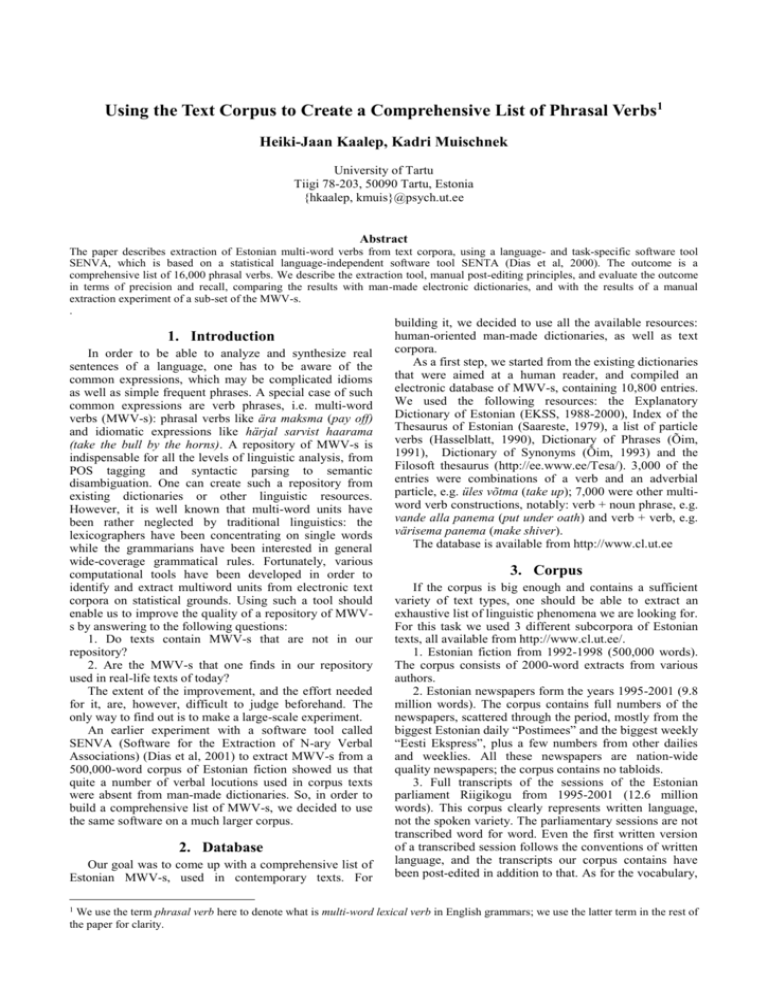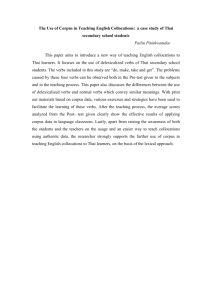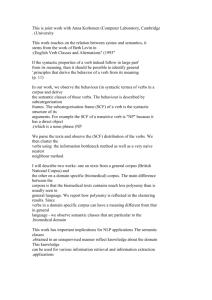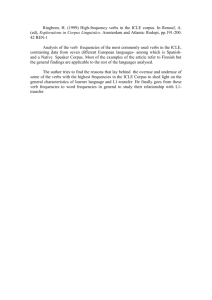Paper Title
advertisement

Using the Text Corpus to Create a Comprehensive List of Phrasal Verbs1
Heiki-Jaan Kaalep, Kadri Muischnek
University of Tartu
Tiigi 78-203, 50090 Tartu, Estonia
{hkaalep, kmuis}@psych.ut.ee
Abstract
The paper describes extraction of Estonian multi-word verbs from text corpora, using a language- and task-specific software tool
SENVA, which is based on a statistical language-independent software tool SENTA (Dias et al, 2000). The outcome is a
comprehensive list of 16,000 phrasal verbs. We describe the extraction tool, manual post-editing principles, and evaluate the outcome
in terms of precision and recall, comparing the results with man-made electronic dictionaries, and with the results of a manual
extraction experiment of a sub-set of the MWV-s.
.
1. Introduction
In order to be able to analyze and synthesize real
sentences of a language, one has to be aware of the
common expressions, which may be complicated idioms
as well as simple frequent phrases. A special case of such
common expressions are verb phrases, i.e. multi-word
verbs (MWV-s): phrasal verbs like ära maksma (pay off)
and idiomatic expressions like härjal sarvist haarama
(take the bull by the horns). A repository of MWV-s is
indispensable for all the levels of linguistic analysis, from
POS tagging and syntactic parsing to semantic
disambiguation. One can create such a repository from
existing dictionaries or other linguistic resources.
However, it is well known that multi-word units have
been rather neglected by traditional linguistics: the
lexicographers have been concentrating on single words
while the grammarians have been interested in general
wide-coverage grammatical rules. Fortunately, various
computational tools have been developed in order to
identify and extract multiword units from electronic text
corpora on statistical grounds. Using such a tool should
enable us to improve the quality of a repository of MWVs by answering to the following questions:
1. Do texts contain MWV-s that are not in our
repository?
2. Are the MWV-s that one finds in our repository
used in real-life texts of today?
The extent of the improvement, and the effort needed
for it, are, however, difficult to judge beforehand. The
only way to find out is to make a large-scale experiment.
An earlier experiment with a software tool called
SENVA (Software for the Extraction of N-ary Verbal
Associations) (Dias et al, 2001) to extract MWV-s from a
500,000-word corpus of Estonian fiction showed us that
quite a number of verbal locutions used in corpus texts
were absent from man-made dictionaries. So, in order to
build a comprehensive list of MWV-s, we decided to use
the same software on a much larger corpus.
2. Database
Our goal was to come up with a comprehensive list of
Estonian MWV-s, used in contemporary texts. For
1
building it, we decided to use all the available resources:
human-oriented man-made dictionaries, as well as text
corpora.
As a first step, we started from the existing dictionaries
that were aimed at a human reader, and compiled an
electronic database of MWV-s, containing 10,800 entries.
We used the following resources: the Explanatory
Dictionary of Estonian (EKSS, 1988-2000), Index of the
Thesaurus of Estonian (Saareste, 1979), a list of particle
verbs (Hasselblatt, 1990), Dictionary of Phrases (Õim,
1991), Dictionary of Synonyms (Õim, 1993) and the
Filosoft thesaurus (http://ee.www.ee/Tesa/). 3,000 of the
entries were combinations of a verb and an adverbial
particle, e.g. üles võtma (take up); 7,000 were other multiword verb constructions, notably: verb + noun phrase, e.g.
vande alla panema (put under oath) and verb + verb, e.g.
värisema panema (make shiver).
The database is available from http://www.cl.ut.ee
3. Corpus
If the corpus is big enough and contains a sufficient
variety of text types, one should be able to extract an
exhaustive list of linguistic phenomena we are looking for.
For this task we used 3 different subcorpora of Estonian
texts, all available from http://www.cl.ut.ee/.
1. Estonian fiction from 1992-1998 (500,000 words).
The corpus consists of 2000-word extracts from various
authors.
2. Estonian newspapers form the years 1995-2001 (9.8
million words). The corpus contains full numbers of the
newspapers, scattered through the period, mostly from the
biggest Estonian daily “Postimees” and the biggest weekly
“Eesti Ekspress”, plus a few numbers from other dailies
and weeklies. All these newspapers are nation-wide
quality newspapers; the corpus contains no tabloids.
3. Full transcripts of the sessions of the Estonian
parliament Riigikogu from 1995-2001 (12.6 million
words). This corpus clearly represents written language,
not the spoken variety. The parliamentary sessions are not
transcribed word for word. Even the first written version
of a transcribed session follows the conventions of written
language, and the transcripts our corpus contains have
been post-edited in addition to that. As for the vocabulary,
We use the term phrasal verb here to denote what is multi-word lexical verb in English grammars; we use the latter term in the rest of
the paper for clarity.
these debates contain a lot of legislative slang, but
surprisingly also a lot of idioms and sayings.
The balance between these corpora is far from perfect.
We would have liked to have much more fiction texts to
analyze, but these are not easily available in the electronic
form. It would have been possible to obtain fiction texts
from earlier periods, but we wanted to stick to the
contemporary ones as the Estonian language has
undergone quite a big change during the beginning of the
1990s.
4. SENVA, a tool for finding MWV-s
The task of finding Estonian MWV-s is a difficult one.
Estonian is a Finno-Ugric language, the closest relative of
it being Finnish. It is a flective language with free word
order. Its syntax has, however, been strongly influenced
by German, and the usage of phrasal verbs in Estonian is
often viewed as being similar to German, characterized by
long distance dependencies between words.
Estonian verbs and nouns have tens of different
inflected forms. Adverbs, adpositions (pre- and
postpositions) and inflectional forms of nouns are often
homonymous with each other. Depending on the type of
the clause (e.g. main or relative), the order of the
components of a multi-word verbal unit may vary. The
words of a MWV may be intervened by other words of the
sentence.
All this results in a multitude of possible patterns for a
single MWV, and consequently in a huge number of
collocations that should be evaluated in order to find the
linguistically motivated ones.
Thus we face the following tasks:
1. Diminish the set of different word combinations that
have to be evaluated.
2. Find the words that occur together more often than
they would by chance.
3. From these, find collocations that form MWV-s.
For solving these tasks we have to combine linguistic
and statistical methods with manual editing.
Below we will describe the phases of the tool: corpus
preparation, collocation extraction and statistical
processing.
4.1.
Corpus preparation
We take advantage of the fact that in the case of
MWV-s, the verb itself may inflect freely, while the other
words tend to be frozen forms. So we can diminish the set
of different collocations by converting the verbs to their
base forms. To do that, we first perform a full
morphological analysis and disambiguation of the text.
Then we keep the base form for the verbs, mark the verbs
for subsequent collocation selection, and retain the
original word form for all the other words.
4.2.
Collocation selection
Defining a good the set of collocations for subsequent
statistical analysis and manual evaluation is of extreme
importance. This phase has a profound influence on the
precision and recall rates of the tool.
We select all the possible collocations from the
linguistically processed corpus, adhering to the following
principles.
1. We limit our collocations to 2- and 3-grams, as
these are by far the most frequent types of Estonian
MWV-s.
2. A MWV cannot cross the border of a clause.
3. Its components should not be further apart than a
fixed number of intervening words. We set the number to
0, 1, 2 and 3 in four separate runs of SENVA on the same
corpus.
4. We select only collocations with a verb (which we
had marked in the corpus preparation phase).
5. We reject collocations that contain certain words
that cannot be part of MWV-s:
- proper names
- pronouns (with a few exceptions)
- conjunctions
- auxiliary verbs olema (to be) and ära (don’t)
- 100 adverbs (e.g. palju (much), taas (again))
- 3,000 word forms of nouns that are either too
common (e.g. öösel (at night), faktid (facts)) or too
specific (e.g. advokaat (lawyer), arutelu (discussion)) to
be part of a MWV.
We created these lists of adverbs and nouns in the
following way. First, we extracted all the collocations
from a corpus. Then we created a frequency list of single
words from this list of collocations, and picked for manual
inspection words that were never found in our database of
MWV-s. We checked the top of this list and marked the
words that we considered impossible to be found in a
MWV.
6. Sort the words in every collocation so that the verb
will be the last component. Thus the collocations will
have the form, used in the dictionaries.
4.3.
Statistical analysis
Statistical analysis is performed on the set of
collocations, extracted in the previous phase.
The statistical tool we use is SENTA (Software for
Extracting N-ary Textual Associations) developed by
(Dias et al., 2000) and tailored by us for the specific case
of extracting Estonian MWV-s. Below we briefly describe
SENTA’s underlying principles.
4.3.1. The Mutual Expectation measure (ME)
By definition, multiword lexical units are groups of
words that occur together more often than expected by
chance. From this assumption, (Dias et al., 2000) have
defined a mathematical model to describe the degree of
cohesiveness between the words of an n-gram.
The normalized expectation (NE) existing between n
words is defined as the average expectation of one word to
occur in a given position, knowing the occurrence of the
other n-1 words also constrained by their positions. For
example, the average expectation of the 3-gram take into
custody must take into account the expectation of
occurring custody after take into, but also the expectation
of into linking together take and custody, and finally the
expectation of take to occur before into custody. The basic
idea of NE is to evaluate the cost of the possible loss of
one word in an n-gram. The less an n-gram accepts the
loss of one of its components, the higher its normalized
expectation will be. NE is thus defined as the probability
of an n-gram, divided by the arithmetic mean of the
probabilities of n-1-grams it contains:
NE
prob(n gram)
1
prob(n 1 grams)
n
So, the more n-1-grams occur somewhere else besides
inside the n-gram, the bigger the arithmetic mean will be,
and consequently, the smaller NE for this particular ngram will be.
NE can be viewed as a generalization of the Dice
coefficient (Smadja 1993), which is equivalent to NE for
bigrams:
Dice ( x, y )
prob ( x, y )
1
( prob ( x) prob ( y ))
2
From the assumption that one effective criterion for
multiword unit identification is simple frequency (Daille
1995), it is posed that between two n-grams with the same
normalized expectation, the most frequent n-gram is more
likely to be a multiword unit:
ME prob(n gram) NE (n gram)
When calculating ME for a text corpus containing N
running words, the formula, using absolute frequencies,
will be:
ME
freq(n gram)
freq(n gram)
1
N
freq(n 1 grams)
n
4.3.2. The GenLocalMaxs Algorithm
Once SENTA has calculated the ME for an n-gram, as
well as for its n-1-grams and shorter -grams contained in
it, it uses the GenLocalMaxs algorithm to decide which
one among them to choose. The algorithm assumes that an
n-gram is a multiword unit if the degree of cohesiveness
between its n words is higher than or equal to the degree
of cohesiveness of any sub-group of (n-1) words
contained in the n-gram, and if it is strictly higher than the
degree of cohesiveness of any super-group of (n+1)
words, containing all the words of the n-gram. In other
words, an n-gram, let’s say W, is a multiword unit if its
ME value, ME(W), is a local maximum. If set of the ME
values of all the (n-1)-grams contained in the n-gram W, is
denoted by n-1 and the set of the ME values of all the
(n+1)-grams containing the n-gram W, by n+1, then the
GenLocalMaxs algorithm is defined as follows in Figure
1.
x n-1 , y n+1
if n=2 then
if ME(W) > ME(y)
then W is a multiword unit
else
if ME(x) ME(W) and ME(W) > ME(y)
then W is a multiword unit
Figure 1: The GenLocalMaxs
For the purpose of our task we found that
GenLocalMaxs is sometimes too rigid. When we
increased the maximum number of words allowed
between the components of a MWV, we got some new
good candidates, but also lost some. So we decided to run
SENVA on the same corpus for 4 times, each time setting
a different limit (0-3) to the maximum number of
intervening words. Then we merged the outputs for
manual inspection. This increased the likelihood that good
MWV-s are extracted, but it also increased the volume of
the output.
5. Manual post-editing
We considered everything that passed trough the
GenLocalMaxs filter as valid output, even collocations
with a frequency of 2 and ME so small that it was shown
as zero. Interestingly, such collocations sometimes
appeared to be true MWV-s. The decision not to set a
frequency or ME-based threshold meant that we had to
spend more effort on manual evaluation of the selected
collocations.
To select MWV-s from the output, we first grouped it
by the verbs. Then one of us browsed through the
collocations and marked the ones (s)he considered true
MWV-s. This selection was in turn checked by another
person.
In the decision process we were guided by the
principles, observable in the database of MWV-s, based
on human-oriented dictionaries: productively formed
MWV-s should not, as a rule, be included.
We discarded the candidate for a MWV when:
1. The verb and its collocate do not form a
grammatical MWV, e.g. aastal hukkuma (perish in the
year of)
2. The collocate may be used in conjunction with any
verb of the same type, e.g. asju korraldama,
organiseerima jne (arrange, organize etc. things)
3. The verb has a multitude of collocates of the same
type, e.g. aktsiaid, maju jne ostma (buy shares, houses
etc.).
4. The collocate is an adverb that acts as a free
combination, typically answering the question “how”,
“when” or “where”, e.g. valjusti (loudly), äsja (recently),
saalis (in the hall).
We decided to include a phrase if the meaning of the
verb was clearly altered by the context. This principle was
hard to follow in practice, though. If a function word like
an adverbial particle gives the verb a new meaning, then it
is straightforward to classify the collocation as a MWV.
Content words, in contrast, always add something to the
meaning. E.g. palka saama (get a salary) and AIDSi
saama (get AIDS) have very different meanings, but then,
almost everything can be got, so we decided not to include
these phrases.
As a rule of thumb, we included phrases were the verb
is used non-literally.
Another rule we followed was: if a collocation
includes uncommon word(s), it is more likely to get into
the list of MWV-s.
6. Results and evaluation
We ran SENVA on three corpora – fiction texts,
parliament transcriptions and newspapers.
The following table lists the number of different
MWV-s found in the corpora, after manual pruning of the
candidate lists that were output by SENVA.
multi-word verbs
of these,
in the database
not in the database
fiction
3,000
1,900
parliam.
5,800
2,600
newsp.
8,500
4,200
1,100
3,200
4,300
Table 1: MWV-s in the corpora.
A considerable part of all the MWV-s found in the
corpora was missing from the original man-made
dictionaries that had been the sources for our database.
These are the MWV-s we were after and finding them in
such great numbers justified the whole undertaking.
If we view the MWV extraction results from all the 3
corpora together, we find that they contain 10,900
different multi-word verbs, 4,900 of which had been listed
in the database before, and 6,000 of which are new
acquisitions from the corpora.
The database we created from human-oriented
dictionaries originally contained 10,800 entries, 5,900 of
which were not found in any of the corpora. It is highly
likely that a lot of them should be eventually discarded
from the list of present-day Estonian MWV-s.
The surprisingly large section of the database that
could not be found in the corpora may be explained by
two reasons. First, much attention of the dictionarymakers has been caught by idioms and sayings that are
known to be rare in the (written) language. Second, these
dictionaries tend to reflect the language of the fiction and
especially the language used in the Estonian fiction up to
the eighties of the 20th century, that is before the period
we chose our corpus texts from.
6.1.
Precision
Using corpora in the size of 10 million words for
extracting MWV-s, however, proved to be considerably
more laborious than we had expected from the previous
experience with a 0.5 million word corpus.
The following table lists the sizes of the corpora, the
number of different n-grams SENVA extracted, the
number of true multi-word verbs, and the precision.
words (in millions)
extracted n-grams
multi-word verbs
precision
fiction
0.5
14,500
3,000
21%
parliam.
12.6
272,000
5,800
2%
newsp.
9.8
308,000
8,500
3%
Table 2. Precision in different corpora.
We can see that the growth of corpora by 20 times
brought along the increase in the number of extracted ngrams in the same magnitude, while the number of MWVs increased only 2-3 times, which in turn resulted in a
considerable decline in precision.
What we see here is similar to the increase of the size
of a corpus, compared with the increase in the size of the
wordform lexicon of the same corpus.
We were interested in maximal recall, so we did not
make any attempts to diminish the number of n-grams, if
it resulted in even a small decline in recall.
6.2.
Recall
In order to estimate the recall of SENVA, that is the
proportion of all the multi-word verbs in the corpus that
SENVA was able to present for linguistic evaluation, we
made the following experiment. We selected randomly
500 entries from our database. We checked the corpora
manually for these MWV-s, and compared the result with
the findings of SENVA. In principle, SENVA can find
only phrases that occur at least twice in the corpus. The
results are presented in the following table:
set of MWV-s
in the corpus
extracted by
SENVA
recall
fiction
500
71
61
parliam.
500
130
107
journal.
500
221
188
86%
82%
85%
Table 3: Recall in different corpora.
We may conclude from the experiment that 18-14% of
the frequently occurring multi-word verbs remain
undiscovered by SENVA.
By far the commonest reason for not finding a good
candidate lies in the nature of GenLocalMaxs algorithm. If
a multi-word verb occurs frequently in a certain context,
this wider context will prevail over the shorter. E.g. in the
Parliament transcriptions we find that üles võtma (take up)
occurs in the contexts kutsuma üles võtma (call to take up)
and teemat üles võtma (take up a theme) so often that the
3-grams are selected as candidates for MWV-s, thus
neglecting the 2-gram.
The most promising way to remedy this deficiency
would be to eliminate bad n-grams on linguistic grounds,
e.g. to eliminate n-grams containing both a modal verb
and a main verb. This would give the good n-grams a
better chance for getting selected by GenLocalMaxs.
7. Conclusion
We set us a goal to build a comprehensive list of
Estonian multi-word verbs. We started from dictionaries
aimed at human readers and added up the information they
contained, resulting in a database of MWV-s. However,
this database contained a lot of rarely used idioms and
lacked many verbal locutions widely used in texts. So, in
order to make a comprehensive list of Estonian MWV-s,
we decided to extract verbal locutions from a large text
corpus using a language- and task-specific software tool
SENVA, which is based on a statistical languageindependent software tool SENTA (Dias et al, 2000). This
work resulted in a freely available database of Estonian
MWV-s, containing 16,000 entries, 6,000 of which were
new MWV-s, extracted from the corpora.
8. Acknowledgments
The work has been sponsored by an Estonian Science
Foundation grant 4352.
9. References
Daille B., 1995 Study and Implementation of Combined
Techniques for Automatic Extraction of Terminology.
In: J. Klavans and P. Resnik (eds.). The Balancing Act:
Combining Symbolic and Statistical Approaches to
Language, (pp. 49-66). Cambridge, MA; London,
England: MIT Press.
Dias, G., Guilloré, S., Bassano, J.C., Lopes, J.G.P,, 2000.
Extraction Automatique d'unités Lexicales Complexes:
Un Enjeu Fondamental pour la Recherche
Documentaire. In: Christian Jacquemin (ed.), Journal
Traitement Automatique des Langues, 41/2:447-473.
Dias, G., Kaalep, H-J., Muischnek, K., 2001. Automatic
Extraction of Verb Phrases from Annotated Corpora: A
Linguistic Evaluation for Estonian. In: ACL 39th
Annual Meeting and 10th Conference of the European
Chapter. Workshop: Collocation: Computational
Extraction, Analysis and Exploitation,(pp. 47-53).
Institut de Recherche en Informatique de Toulouse and
Universite des Sciences Sociales. Toulouse, France.
EKSS 1988 – 2000, Eesti kirjakeele seletussõnaraamat..
Tallinn: ETA KKI.
Hasselblatt, C., 1990. Das Estnische Partikelverb als
Lehnübersetzung aus dem Deutschen, Wiesbaden.
Saareste, A., 1979. Eesti keele mõistelise sõnaraamatu
indeks. Finsk-ugriska institutionen, Uppsala.
Smadja F., 1993. Retrieving Collocations from Text:
XTRACT. Computational Linguistics, 19/1:143-177.
Õim, A., 1993. Fraseoloogiasõnaraamat. ETA KKI,
Tallinn, Estonia.
Õim, A., 1991. Sünonüümisõnastik. Tallinn, Estonia.






